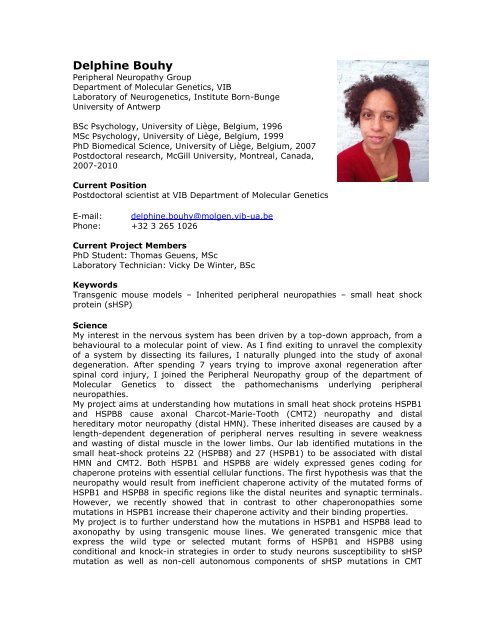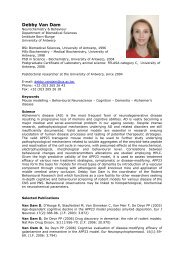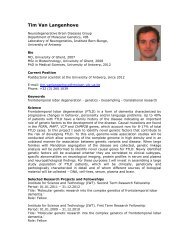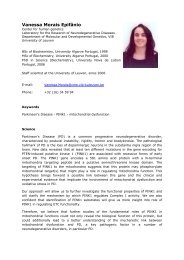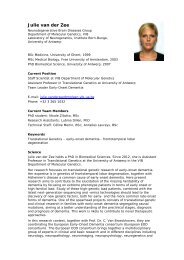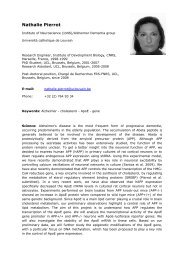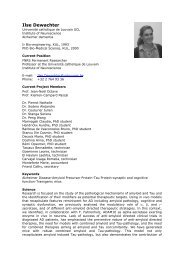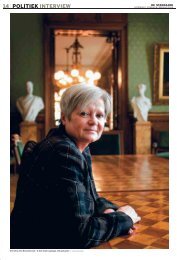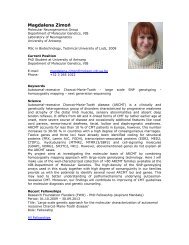Delphine Bouhy
Nathalie Brouwers - Department of Molecular Genetics
Nathalie Brouwers - Department of Molecular Genetics
- No tags were found...
You also want an ePaper? Increase the reach of your titles
YUMPU automatically turns print PDFs into web optimized ePapers that Google loves.
<strong>Delphine</strong> <strong>Bouhy</strong><br />
Peripheral Neuropathy Group<br />
Department of Molecular Genetics, VIB<br />
Laboratory of Neurogenetics, Institute Born-Bunge<br />
University of Antwerp<br />
BSc Psychology, University of Liège, Belgium, 1996<br />
MSc Psychology, University of Liège, Belgium, 1999<br />
PhD Biomedical Science, University of Liège, Belgium, 2007<br />
Postdoctoral research, McGill University, Montreal, Canada,<br />
2007-2010<br />
Current Position<br />
Postdoctoral scientist at VIB Department of Molecular Genetics<br />
E-mail: delphine.bouhy@molgen.vib-ua.be<br />
Phone: +32 3 265 1026<br />
Current Project Members<br />
PhD Student: Thomas Geuens, MSc<br />
Laboratory Technician: Vicky De Winter, BSc<br />
Keywords<br />
Transgenic mouse models – Inherited peripheral neuropathies – small heat shock<br />
protein (sHSP)<br />
Science<br />
My interest in the nervous system has been driven by a top-down approach, from a<br />
behavioural to a molecular point of view. As I find exiting to unravel the complexity<br />
of a system by dissecting its failures, I naturally plunged into the study of axonal<br />
degeneration. After spending 7 years trying to improve axonal regeneration after<br />
spinal cord injury, I joined the Peripheral Neuropathy group of the department of<br />
Molecular Genetics to dissect the pathomechanisms underlying peripheral<br />
neuropathies.<br />
My project aims at understanding how mutations in small heat shock proteins HSPB1<br />
and HSPB8 cause axonal Charcot-Marie-Tooth (CMT2) neuropathy and distal<br />
hereditary motor neuropathy (distal HMN). These inherited diseases are caused by a<br />
length-dependent degeneration of peripheral nerves resulting in severe weakness<br />
and wasting of distal muscle in the lower limbs. Our lab identified mutations in the<br />
small heat-shock proteins 22 (HSPB8) and 27 (HSPB1) to be associated with distal<br />
HMN and CMT2. Both HSPB1 and HSPB8 are widely expressed genes coding for<br />
chaperone proteins with essential cellular functions. The first hypothesis was that the<br />
neuropathy would result from inefficient chaperone activity of the mutated forms of<br />
HSPB1 and HSPB8 in specific regions like the distal neurites and synaptic terminals.<br />
However, we recently showed that in contrast to other chaperonopathies some<br />
mutations in HSPB1 increase their chaperone activity and their binding properties.<br />
My project is to further understand how the mutations in HSPB1 and HSPB8 lead to<br />
axonopathy by using transgenic mouse lines. We generated transgenic mice that<br />
express the wild type or selected mutant forms of HSPB1 and HSPB8 using<br />
conditional and knock-in strategies in order to study neurons susceptibility to sHSP<br />
mutation as well as non-cell autonomous components of sHSP mutations in CMT
neuropathies. We will study the phenotype of these transgenic lines and will also use<br />
them to validate our recent results and develop therapeutic strategies.<br />
Recent Grants and Fellowships<br />
Association Belge contre Les Maladies neuro-Musculaires (ABMM) – Research Grant<br />
Period: 2011-2012<br />
Title: ‘Transgenic models to identify Charcot-Marie-Tooth pathomechanisms caused<br />
by mutations in HSPB1 and HSPB8’<br />
Selected Publications<br />
<strong>Bouhy</strong> D, Ghasemlou N, Lively S, Redensek A, Rathore KI, Schlichter LC, David S:<br />
Inhibition of the Ca²+-dependent K+ channel, KCNN4/KCa3.1, improves tissue<br />
protection and locomotor recovery after spinal cord injury. Journal of Neuroscience.<br />
Epub 2011 (I.F.: 7.115) (PMID: 22072681)<br />
Ghasemlou N, <strong>Bouhy</strong> D, Yang J, Lopez-Vales R, Haber M, Thuraisingam T, He G,<br />
Radzioch D, Ding, David S : Beneficial effects of secretory leukocyte protease<br />
inhibitor after spinal cord injury. Brain. Epub 2010 (I.F.: 9.230) (PMID: 20047904)<br />
Girolami E, <strong>Bouhy</strong> D, Haber M, Johnson H, David S: Differential expression and<br />
potential role of SOCS1 and SOCS3 in Wallerian degeneration in injured peripheral<br />
nerve. Exp Neurol. Epub 2009 (I.F.: 4.436) (PMID: 19576891)<br />
<strong>Bouhy</strong> D, Malgrange B, Multon S, Poirrier A-L, Scholtes F, Schoenen J and Franzen R<br />
(2006) Delayed GM-CSF treatment stimulates axonal regeneration and functional<br />
recovery in paraplegic rats via an increased BDNF expression by endogenous<br />
macrophages. The FASEB Journal. Epub 2006 (I.F.: 7.049) (PMID: 16636109)<br />
All Publications


